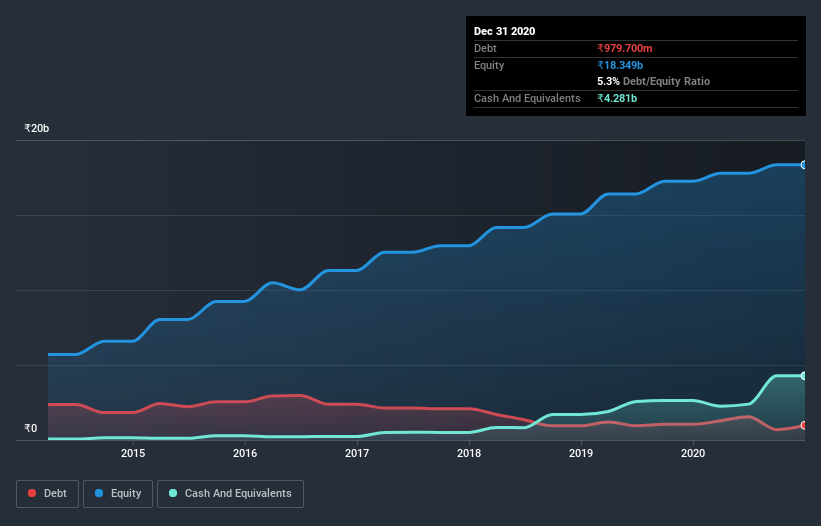Is Kajaria Ceramics (NSE:KAJARIACER) Using Too Much Debt?

Legendary fund manager Li Lu (who Charlie Munger backed) once said, 'The biggest investment risk is not the volatility of prices, but whether you will suffer a permanent loss of capital.' When we think about how risky a company is, we always like to look at its use of debt, since debt overload can lead to ruin. Importantly, Kajaria Ceramics Limited (NSE:KAJARIACER) does carry debt. But should shareholders be worried about its use of debt?
When Is Debt A Problem?
Generally speaking, debt only becomes a real problem when a company can't easily pay it off, either by raising capital or with its own cash flow. Part and parcel of capitalism is the process of 'creative destruction' where failed businesses are mercilessly liquidated by their bankers. While that is not too common, we often do see indebted companies permanently diluting shareholders because lenders force them to raise capital at a distressed price. Having said that, the most common situation is where a company manages its debt reasonably well - and to its own advantage. The first thing to do when considering how much debt a business uses is to look at its cash and debt together.
See our latest analysis for Kajaria Ceramics
What Is Kajaria Ceramics's Net Debt?
You can click the graphic below for the historical numbers, but it shows that Kajaria Ceramics had ₹690.9m of debt in September 2020, down from ₹1.05b, one year before. However, its balance sheet shows it holds ₹4.28b in cash, so it actually has ₹3.59b net cash.

How Strong Is Kajaria Ceramics' Balance Sheet?
Zooming in on the latest balance sheet data, we can see that Kajaria Ceramics had liabilities of ₹3.91b due within 12 months and liabilities of ₹1.44b due beyond that. On the other hand, it had cash of ₹4.28b and ₹3.37b worth of receivables due within a year. So it actually has ₹2.29b more liquid assets than total liabilities.
Having regard to Kajaria Ceramics' size, it seems that its liquid assets are well balanced with its total liabilities. So while it's hard to imagine that the ₹155.4b company is struggling for cash, we still think it's worth monitoring its balance sheet. Simply put, the fact that Kajaria Ceramics has more cash than debt is arguably a good indication that it can manage its debt safely.
But the bad news is that Kajaria Ceramics has seen its EBIT plunge 13% in the last twelve months. We think hat kind of performance, if repeated frequently, could well lead to difficulties for the stock. The balance sheet is clearly the area to focus on when you are analysing debt. But it is future earnings, more than anything, that will determine Kajaria Ceramics's ability to maintain a healthy balance sheet going forward. So if you're focused on the future you can check out this free report showing analyst profit forecasts.
Finally, while the tax-man may adore accounting profits, lenders only accept cold hard cash. Kajaria Ceramics may have net cash on the balance sheet, but it is still interesting to look at how well the business converts its earnings before interest and tax (EBIT) to free cash flow, because that will influence both its need for, and its capacity to manage debt. Over the most recent three years, Kajaria Ceramics recorded free cash flow worth 57% of its EBIT, which is around normal, given free cash flow excludes interest and tax. This cold hard cash means it can reduce its debt when it wants to.
Summing up
While it is always sensible to investigate a company's debt, in this case Kajaria Ceramics has ₹3.59b in net cash and a decent-looking balance sheet. So we are not troubled with Kajaria Ceramics's debt use. The balance sheet is clearly the area to focus on when you are analysing debt. However, not all investment risk resides within the balance sheet - far from it. For example - Kajaria Ceramics has 2 warning signs we think you should be aware of.
At the end of the day, it's often better to focus on companies that are free from net debt. You can access our special list of such companies (all with a track record of profit growth). It's free.
If you decide to trade Kajaria Ceramics, use the lowest-cost* platform that is rated #1 Overall by Barron’s, Interactive Brokers. Trade stocks, options, futures, forex, bonds and funds on 135 markets, all from a single integrated account. Promoted
If you're looking to trade Kajaria Ceramics, open an account with the lowest-cost platform trusted by professionals, Interactive Brokers.
With clients in over 200 countries and territories, and access to 160 markets, IBKR lets you trade stocks, options, futures, forex, bonds and funds from a single integrated account.
Enjoy no hidden fees, no account minimums, and FX conversion rates as low as 0.03%, far better than what most brokers offer.
Sponsored ContentValuation is complex, but we're here to simplify it.
Discover if Kajaria Ceramics might be undervalued or overvalued with our detailed analysis, featuring fair value estimates, potential risks, dividends, insider trades, and its financial condition.
Access Free AnalysisThis article by Simply Wall St is general in nature. It does not constitute a recommendation to buy or sell any stock, and does not take account of your objectives, or your financial situation. We aim to bring you long-term focused analysis driven by fundamental data. Note that our analysis may not factor in the latest price-sensitive company announcements or qualitative material. Simply Wall St has no position in any stocks mentioned.
*Interactive Brokers Rated Lowest Cost Broker by StockBrokers.com Annual Online Review 2020
Have feedback on this article? Concerned about the content? Get in touch with us directly. Alternatively, email editorial-team (at) simplywallst.com.
About NSEI:KAJARIACER
Kajaria Ceramics
Manufactures, sells, and distributes ceramic and vitrified wall and floor tiles under the Kajaria, GresBond, and Eternity brands in India and internationally.
Flawless balance sheet average dividend payer.
Similar Companies
Market Insights
Community Narratives




